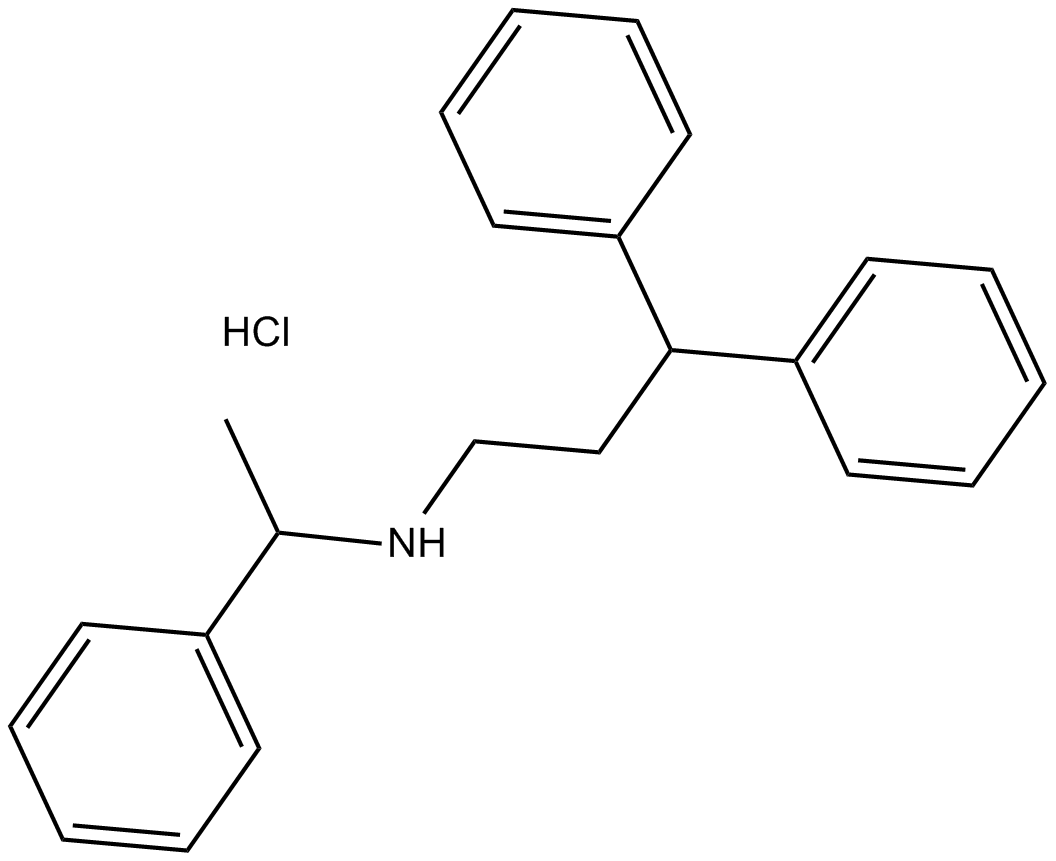Fendiline (hydrochloride) |
| Catalog No.GC18086 |
α2-adrenergic receptor antagonist
Products are for research use only. Not for human use. We do not sell to patients.

Cas No.: 13636-18-5
Sample solution is provided at 25 µL, 10mM.
Fendiline is an α2-adrenergic receptor antagonist and L-type calcium channel blocker [1,2].
The α2 adrenergic receptor is a G protein-coupled receptor (GPCR). Until now, three different α2-receptor subtypes have been identified: α2A, α2B, and α2C. The α2-adrenergic receptor exists in vascular prejunctional terminals and inhibits the release of norepinephrine in a form of negative feedback. The α2 adrenergic receptor agonists produce diverse responses, including analgesia, sedation, anxiolysis, and sympatholysis [3]. L-type calcium channels are responsible for the excitation-contraction coupling of skeletal, cardiac muscle, smooth, and for aldosterone secretion in endocrine cells of the adrenal cortex [4].
Fendiline inhibited the activity of L-type Ca2+ channel blocker with the IC50 value of 17 μM [1]. Fendiline inhibited the activity of α2-adrenergic receptor with the Kd of 2.6 μM [2]. Fendiline significantly reduced nanoclustering of K-Ras and redistributed K-Ras from the plasma membrane to the endoplasmic reticulum (ER), Golgi apparatus, endosomes, and cytosol. Fendiline significantly inhibited signaling downstream of constitutively active K-Ras and endogenous K-Ras signaling in cells transformed by oncogenic H-Ras. Fendiline blocked the proliferation of pancreatic, colon, lung, and endometrial cancer cell lines expressing oncogenic mutant K-Ras [5]. Fendiline inhibited K-Ras plasma membrane localization with an IC50 of 9.64 μM [5]. Fendiline is an anti-anginal agent for the treatment of coronary heart disease. The anti-anginal and anti-ischaemic efficacy of fendiline has been proven in several placebo-controlled, double-blind trials [6].
References:
[1] Tripathi, O. ,Schreibayer, W., and Tritthart, H.A. Fendiline inhibits L-type calcium channels in guinea-pig ventricular myocytes: A whole-cell patch-clamp study. British Journal of Pharmacology 108(4), 865-869 (1993).
[2] Motulsky, H. J.,Snavely, M.D.,Hughes, R.J., et al. Interaction of verapamil and other calcium channel blockers with α1- and α2-adrenergic receptors. Circulation Research 52(2), 226-231 (1983).
[3] Kamibayashi T, Maze M. Clinical uses of α2-adrenergic agonists[J]. The Journal of the American Society of Anesthesiologists, 2000, 93(5): 1345-1349.
[4] Lipscombe D. L-type calcium channels[J]. 2002.
[5] van der Hoeven D, Cho K, Ma X, et al. Fendiline inhibits K-Ras plasma membrane localization and blocks K-Ras signal transmission[J]. Molecular and cellular biology, 2013, 33(2): 237-251.
[6] Bayer R, Mannhold R. Fendiline: a review of its basic pharmacological and clinical properties[J]. Pharmatherapeutica, 1986, 5(2): 103-136.
Average Rating: 5 (Based on Reviews and 6 reference(s) in Google Scholar.)
GLPBIO products are for RESEARCH USE ONLY. Please make sure your review or question is research based.
Required fields are marked with *




















